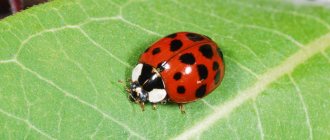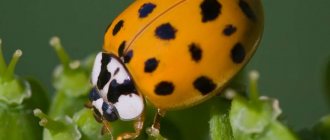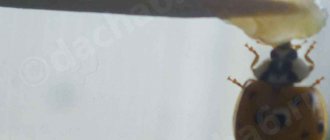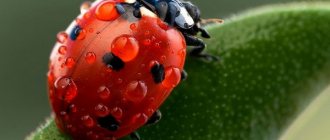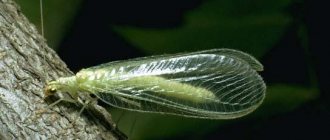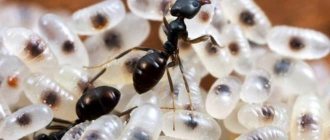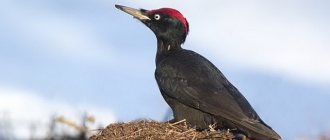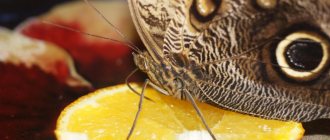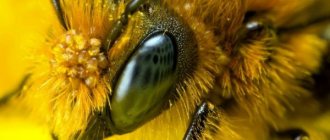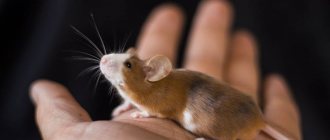- Encyclopedia
- The world
- Ladybug
The ladybug is a very common insect. They live on almost the entire planet, with the exception of Antarctica and permafrost. There are more than 4,000 species of these insects in the world. Some of them live on trees and bushes, others in the grass.
Ladybugs have very original and varied colors. The color of the elytra can be red, yellow, black, brown, blue. The spots are yellow, black, and white. They may merge with each other, or they may be absent. The colors are brighter in young individuals, but fade over time.
They belong to the family - beetles, order - Coleoptera. The shape of the body is convex at the top and flat at the bottom, round or oval. Length from 4 to 10 mm.
The seven-spotted ladybug is the most common in Russia. Body length 7-8 mm. Color – red with black spots.
Body structure of a ladybug:
— The head is small, motionless. The antennae are flexible and consist of 8-11 segments.
— Pronotum – convex, transverse.
- 3 pairs of legs, each of which consists of 4 segments: 3 visible, 1 hidden.
— The abdomen consists of 6 segments, which are covered with segmental semirings.
— 2 rear wings. In 1 second, the ladybug makes 85 swings with them.
— Fender flaps are necessary to protect the rear wings.
Ladybugs live from several months to 1 year. Most of them are predators. They feed on aphids. In Southeast Asia there are species that feed on plants.
Ladybug can protect itself from enemies. She secretes a toxic yellow liquid from her paws. In this way, the ladybug scares away spiders, frogs and other insects. Birds don't feed on them.
Ladybugs benefit people. These insects destroy pests that cause serious harm to agriculture.
There are different versions about the origin of such an interesting name. The most popular of them: the poisonous liquid secreted by insects is “milk”, which is why it was called “ladybug”, “ladybug” means that this insect is harmless to people.
In other countries, the ladybug is called differently: in Switzerland and Germany - “Virgin Mary’s bug”, and in Slovenia and the Czech Republic - “Sun”.
What does a ladybug look like: description
The ladybug is a small insect, with a body size of 4-10, 11 mm. The spotted beetle belongs to the order Coleoptera. The body has an elongated, oval-like or roundish shape. If you look from above, the body is highly convex, from below it is flattened. On the surface of many species, hairs are clearly visible - barely noticeable pubescence.
Body structure:
- head;
- front back;
- chest (including 3 sections);
- abdomen;
- 3 pairs of legs;
- wings with hard elytra.
The front back of the beautiful beetle has a transverse structure, highly convex, and a notch is clearly visible on the front edge.
The small head of the spotted beetle is slightly extended forward and motionlessly aligned with the front chest. The eyes are large, not protruding, the antennae are very flexible, consisting of 8 segments.
On the upper part there are spots of various colors and shapes, which do not appear immediately after birth, but after a couple of weeks.
The hind chest, in contrast to the front chest and middle chest, which are extended across the body, looks like a square.
The cute insect has 6 moderately long legs, each of which consists of 3 obvious and one hidden segment. The paws help the bug quickly pick up each blade of grass and crawl through the grass. The abdomen consists of 5-6 segments.
With the help of their hind wings, cute insects take flight. The front wings eventually degenerated into hard elytra. They serve as protection for the hind wings while the insect crawls through the grass.
Bugs of various colors secrete cantharidin (a dangerous poison), thereby protecting them from predators.
The protective covers of the bug can be painted black, yellowish, deep red, brownish or blue with black, red, yellowish or whitish spots. All points have different shapes. In many insects, the spots merge together, forming spreading patterns. Some insects do not have them at all. By the pattern you can understand and determine what gender the ladybug is.
The only enemy of insects is dinocampus. Even the brightly colored insect with spots and the hemolymph secreted by it cannot save the insect from obvious death. The fact is that dinocampus lay eggs precisely in the delicate bodies of ladybird pupae, sometimes even in adult individuals. While developing, individuals parasitize and kill their host.
According to scientists, birds do not pose a danger to insects, since they secrete a toxic substance that is dangerous to birds. The bright coloring signals that birds should not approach and scares them away.
Ladybug - benefit or harm? Friend or foe?
From the encyclopedia we learned that ladybugs are very useful and indispensable in the fight against agricultural pests. They are specially bred in many countries and then released onto coffee, coconut and citrus plantations to kill pests. So gluttony makes beetles faithful allies of humans in the fight against many harmful insects.
And in the summer at the dacha, my grandmother and I conducted an experiment, and now we know for sure that ladybugs are our friends and helpers.
Here's how it happened: aphids appeared in huge numbers on the tomatoes in the greenhouse. We were in despair, the plants were withering before our eyes, the ovaries did not develop, and the harvest was in jeopardy. And then we remembered that ladybugs really love aphids. In a clearing behind the dacha, we caught beetles in a jar and released them into the greenhouse for each plant. After a few days there were no aphids on our tomatoes!
However, not all ladybugs are beneficial. Some of them, feeding on plants, can cause significant harm. Three such species are found in Russia. However, there are few herbivorous ladybugs and the harm from them cannot be compared with the enormous benefit that predatory species bring that exterminate pests.
Where does he live?
Beautiful bugs are distributed across all continents. They populated all zones. The exceptions are areas where the temperature does not exceed 0°C throughout the year and Antarctica.
The insect can be found in all European countries: Great Britain, fragrant in the flowers of Denmark, Sweden, France, Iceland. Germany, Italy, and Poland also sheltered this bright insect. Ladybugs fly over India, Korea, the Islamic Republic, Japan, South and North America, and Mongolia. The distribution area also covers Laos, Myanmar, Indonesia and even Cambodia.
In nature, there are many species of bright representatives of the insect world, their classification is simply huge, and each of them prefers special habitats and each of them has a specific role. Some species settle on plants that have been damaged by aphids. Others can be seen on field and marsh grasses.
What have we learned?
There are many types of ladybugs in nature. Most of them are predators. They help fight small pests in gardens and fields. A description of ladybugs, their lifestyle, information about what ladybugs eat will help 2nd grade students studying the world around them.
Previous
The world around usWhat is granite (grade 2, the world around us) - additional information for children, a brief description for the report
Next
The world around us Why is the sea salty - why there is more salt water in the sea than fresh water briefly for children
Lifestyle
Ladybugs prefer to live “alone”, apart from other representatives of the species.
Only during the mating season do they come together to continue their family line. They also gather together for flights and wintering.
A ladybug can be called a fruit-loving bug, therefore, with the onset of a cold period, all insects living in temperate latitudes gather together and fly away to warm countries.
Among insects there is a sedentary species. They do not fly to countries with hot and dry climates, but gather in one place and winter in huge communities, reaching 400 million adult individuals. If you calculate how much such a “ball” weighs, you can get a figure equal to several tons.
To shelter from unfavorable climatic conditions, the “suns” hide in the ruins of stones and also take cover under fallen leaf blades of shrubs.
Under good conditions and the availability of food, spotted insects can live for 1 year. Under unfavorable conditions, the lifespan of insects does not exceed several months.
Unusual facts about ladybugs
This creature is endowed with some kind of magical power and energy. There are many signs associated with them. And those who believe in omens take care of bugs.
- Ladybug is a harbinger of change for the better.
- In the house during cold weather, a ladybug is considered a blessing.
- The sun on your hand means your dreams will come true, on your clothes means good luck.
Ladybug beetles were even considered messengers from heaven. They could use them to predict the weather. If they quickly fly away from your hand, it will be sunny and clear, but if the beetle is in no hurry, the weather will change.
Some unpleasant stories
Sexual relations
The ladybug's reputation as a cute bug isn't entirely deserved. For example, they are completely promiscuous in sexual relations. A clutch may contain eggs fertilized by several males at once. And sexually transmitted diseases are normal for them.
Cannibalism
Seemingly harmless beetles have a tendency towards cannibalism. With a lack of food, they eat their own eggs and even small larvae. Therefore, they are careful - if the aphid colony already has a clutch, the ladybugs will choose another place.
Ticks
Often, in the process of indiscriminate group relationships, ladybugs transmit pests to each other. One compact beetle can carry up to 80 mites on its own body. And infection reduces the animal’s immunity and egg quality.
Food spoilage
Some ladybugs, in the absence of food, move to berries, fruits and grapes. There are known cases when entire barrels of wine spoiled because there were bugs in the grains that spoiled the taste by releasing their protective substance.
Reproduction
The appearance of offspring depends on the species: insects reproduce in spring or autumn; depending on the variety and belonging to a particular species, an adult individual of a bizarre bug can lay 3-300 eggs.
Ladybug larva: the process of transformation
An interesting fact is that “suns” lay eggs near aphid settlements. The development cycle of the larva lasts no more than a week. While developing, it feeds on aphids daily.
Full maturation occurs by the second week of development. The time is already coming when you can observe the transformation of the larva into a pupa. After 7 weeks, an adult is born from the pupa.
If during growth the insects do not have enough main food - aphids - to saturate their bodies, the bugs fly to the beaches. During the flight, their presence annoys even people. Some people complain of weak bites from the seven-spotted ladybug.
What determines the number of black spots on the back?
No, not because of age, as parents often answer.
The number of dots depends on what type of ladybug. There are a lot of ladybugs - more than 5000 species. And they settled all over the globe except Antarctica. These bugs inhabit open spaces with herbaceous vegetation.
As we found out from the encyclopedia: the ladybug lives only in places with good ecology. Therefore, the number of ladybugs is a direct indicator of the cleanliness of the environment.
Ladybugs come in different colors: pink, yellow, white, orange and even black. And they even have different numbers of points on their backs: from two to twenty-six. And instead of dots there may be stripes, spots, commas. There are even exotic coloring pages that look like a chessboard, or plain colors without dots.
The most common ladybug has seven black dots on its back. That’s what they call it – seven-point.
Why is the ladybug called that?
The bizarre coloration became the basis for giving the insect the scientific name ladybug. People call a bug with fancy inclusions differently. Cute nicknames indicate that people have sympathy for this insect. For example, in the sunny Czech Republic and Slovenia it is called the “sun,” in prosperous Switzerland and Germany it is called the “bug of the Virgin Mary,” and Latin American residents call it “St. Anthony’s cow.”
It is still not known from what origins the Russian name for this beautiful “Virgin Mary bug” came. Some scientists argue that this is due to the ability of a bright bug to secrete hemolymph (“milk”) during times of danger, with which they scare away predators. And “God’s” means harmless, gentle.
According to others, the insect was named so because it copes well with aphids and their sticky secretions, thereby helping to preserve the harvest.
Multi-colored bugs bring undoubted benefits. You can attract bright insects to the garden; if you can’t attract them yourself, then you can buy them in a store and bring them to your site. Nowadays, many environmental companies are breeding these cute bugs, so it won’t be difficult to order them and bring them to your garden, where you can plant them on a prepared lawn.
Why does the ladybug need such a bright outfit?
In the summer we observed that birds never catch ladybugs, although there are so many of them around, and they are also so noticeable. By studying the literature, we found the answer to this question.
It turns out that it is a noticeable and bright outfit that helps the ladybug defend itself from enemies!
And warns about inedibility.
In the encyclopedia, we learned that in case of danger, ladybugs secrete a pungent orange substance with an unpleasant odor and taste. This is a cantharidin poison that burns the throat. A bird only needs to try a ladybug once to remember well: it is inedible!
And in winter, this fact was confirmed by a small experiment: we found dried ladybugs on the balcony and poured them into a feeder along with grain. Maybe the birds will peck the insects. However, the ladybugs remained in the feeder, and the birds didn’t even touch them! This means that the smell of cantharidin also persists in dead insects.
But the ladybug doesn’t release poison on purpose, it’s just the structure of its knees. As soon as the bug tightens its legs, liquid appears. So the ladybug is not at all defenseless.
